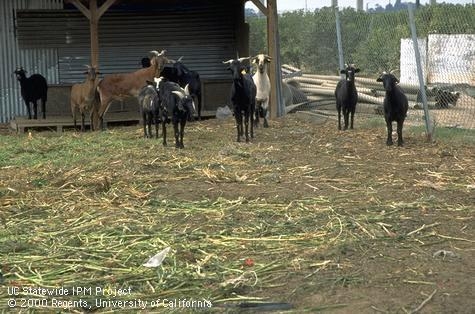I’ll bet a lot of you guessed chicken or pork. Some of you probably thought beef. Surprise! While in the United States, we tend to consume chicken as our white meat choice and beef as our red meat choice 63% of the world's population consumes goat meat. Interestingly, more and more goat meat is being consumed in the United States and not just as an ethnic dish due to the growing ethnic population. The health conscious consumer is also looking at the benefits of incorporating either Cabrito (a delicacy meat from goats that are harvested between 1 to 3 months of age and weigh less than 50 pounds) or Chevon (goats that are harvested between 6 to 9 months of age and weigh between 50 and 75 pounds). Older goat meat is also consumed but usually as sausage or in chili.

The table below shows the nutrient comparison of goat meat to that of traditionally raised chicken, beef pork, and lamb. I suspect that these values are based on grain finishing as we already know that grass finishing will result in slightly different values. They may also be affected by the potential younger age of Chevon.
|
Nutrient Composition of Goat and Other Types of Meat1, 2 |
|||||
|
Nutrient |
Goat |
Chicken |
Beef |
Pork |
Lamb |
|
Calories |
122 |
162 |
179 |
180 |
175 |
|
Fat (g) |
2.6 |
6.3 |
7.9 |
8.2 |
8.1 |
|
Saturated Fat (g) |
0.79 |
1.7 |
3.0 |
2.9 |
2.9 |
|
Protein (g) |
23 |
25 |
25 |
25 |
24 |
|
Cholesterol (mg) |
63.8 |
76.0 |
73.1 |
73.1 |
78.2 |
|
1 Per 3 oz. of cooked meat |
|||||
|
2 USDA Nutrient Database for Standard Reference, Release 14 (2001) |
|||||
You can see from the above that goat meat is lower in calories, total fat, saturated fat, and cholesterol than traditional meats. Less saturated fat and less cholesterol mean healthier red meat for the health-conscious consumer. Additionally, goat meat has higher levels of iron (3.2mg) when compared to a similar serving size of beef (2.9 mg), pork (2.7 mg), lamb (1.4 mg), and chicken (1.5 mg). Comparatively, goat meat also contains higher potassium content with lower sodium levels. Regarding essential amino acid composition, goat meat closely resembles that of beef and lamb.
With these benefits it’s clear why the consumer is looking at different meats like goat. Ideally as grass-farmers, it makes sense to diversify for the health of our rangeland and for the economic well-being of the ranch. Consider adding goats to your operation.